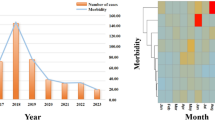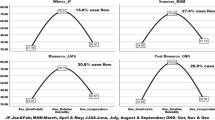Abstract
Seasonal variation in the incidence of tuberculosis (TB) has been widely assumed. However, few studies have investigated the association between extreme temperatures and the incidence of TB. We collected data on cases of TB and mean temperature in Fukuoka, Japan for 2008–2012 and used time-series analyses to assess the possible relationship of extreme temperatures with TB incident cases, adjusting for seasonal and interannual variation. Our analysis revealed that the occurrence of extreme heat temperature events resulted in a significant increase in the number of TB cases (relative risk (RR) 1.20, 95 % confidence interval (CI) 1.01–1.43). We also found that the occurrence of extreme cold temperature events resulted in a significant increase in the number of TB cases (RR 1.23, 95 % CI 1.05–1.45). Sex and age did not modify the effect of either heat or cold extremes. Our study provides quantitative evidence that the number of TB cases increased significantly with extreme heat and cold temperatures. The results may help public health officials predict extreme temperature-related TB incidence and prepare for the implementation of preventive public health interventions.


Similar content being viewed by others
Abbreviations
- CI:
-
Confidence interval
- RR:
-
Relative risk
- TB:
-
Tuberculosis
References
Akhtar S, Mohammad HG (2008) Seasonality in pulmonary tuberculosis among migrant workers entering Kuwait. BMC Infect Dis 8:3
Anderson BG, Bell ML (2009) Weather-related mortality: how heat, cold, and heat waves affect mortality in the United States. Epidemiology 20:205–213
Armstrong B (2006) Models for the relationship between ambient temperature and daily mortality. Epidemiology 17:624–631
Astrom DO, Forsberg B, Edvinsson S, Rocklov J (2013) Acute fatal effects of short-lasting extreme temperatures in Stockholm, Sweden: evidence across a century of change. Epidemiology 24:820–829
Atun RA, Samyshkin YA, Drobniewski F, Kuznetsov SI, Fedorin IM, Coker RJ (2005) Seasonal variation and hospital utilization for tuberculosis in Russia: hospitals as social care institutions. Eur J Public Health 15:350–354
Bassil KL, Cole DC (2010) Effectiveness of public health interventions in reducing morbidity and mortality during heat episodes: a structured review. Int J Environ Res Public Health 7:991–1001
Belay M, Bjune G, Ameni G, Abebe F (2012) Diagnostic and treatment delay among tuberculosis patients in Afar egion, Ethiopia: a cross-sectional study. BMC Public Health 12:369
Borgdorff MW, Sebek M, Geskus RB, Kremer K, Kalisvaart N, van Soolingen D (2011) The incubation period distribution of tuberculosis estimated with a molecular epidemiological approach. Int J Epidemiol 40:964–970
Brumback B, Burge HA, Neas LM, Ryan LM, Schwartz JD, Stark PC (2000) Transitional regression models, with application to environmental time series. J Am Stat Assoc 95:16–27
Cegielski JP, McMurray DN (2004) The relationship between malnutrition and tuberculosis: evidence from studies in humans and experimental animals. Int J Tuberc Lung Dis 8:286–298
Douglas AS, Strachan DP, Maxwell JD (1996) Seasonality of tuberculosis: the reverse of other respiratory diseases in the UK. Thorax 51:944–946
Fares A (2011) Seasonality of tuberculosis. J Glob Infect Dis 3:46–55
Fukuoka Prefectural Government. Fukuoka Prefecture Migration Survey. http://www.pref.fukuoka.lg.jp/dataweb/search-1-1619.html Accessed 31 Jul 2014
Fukuoka Prefectural Government. Fukuoka Prefecture Tuberculosis Report 2013. http://www.pref.fukuoka.lg.jp/contents/tbc-2013.html Accessed 31 Jul 2014
Gasparrini A, Armstrong B, Kenward MG (2010) Distributed lag non-linear models. Stat Med 29:2224–2234
Janmeja AK, Mohapatra PR (2005) Seasonality of tuberculosis. Int J Tuberc Lung Dis 9:704–705
Korthals Altes H, Kremer K, Erkens C, van Soolingen D, Wallinga J (2012) Tuberculosis seasonality in the Netherlands differs between natives and non-natives: a role for vitamin D deficiency? Int J Tuberc Lung Dis 16:639–644
Lawn SD, Zumla AI (2011) Tuberculosis. Lancet 378:57–72
Leung CC, Yew WW, Chan TY, Tam CM, Chan CY, Chan CK et al (2005) Seasonal pattern of tuberculosis in Hong Kong. Int J Epidemiol 34:924–930
Liao CM, Hsieh NH, Huang TL, Cheng YH, Lin YJ, Chio CP et al (2012) Assessing trends and predictors of tuberculosis in Taiwan. BMC Public Health 12:29
Lillebaek T, Dirksen A, Baess I, Strunge B, Thomsen VO, Andersen AB (2002) Molecular evidence of endogenous reactivation of Mycobacterium tuberculosis after 33 years of latent infection. J Infect Dis 185:401–404
Lin YJ, Liao CM (2014) Seasonal dynamics of tuberculosis epidemics and implications for multidrug-resistant infection risk assessment. Epidemiol Infect 142:358–370
Lopez AD, Mathers CD, Ezzati M, Jamison DT, Murray CJL (2006) Global burden of disease and risk factors. World Bank, Washington
Luquero FJ, Sanchez-Padilla E, Simon-Soria F, Eiros JM, Golub JE (2008) Trend and seasonality of tuberculosis in Spain, 1996–2004. Int J Tuberc Lung Dis 12:221–224
McCullagh P, Nelder J (1989) Generalized linear models. Chapman and Hall, London
Ministry of Health, Labour and Welfare (2013) Act on prevention of infectious diseases and medical care for patients suffering infectious diseases. http://www.mhlw.go.jp/bunya/kenkou/kekkaku-kansenshou11/01.html Accessed 1 April 2014
Ministry of Justice. Report on Internal Migration in Japan. http://www.moj.go.jp/housei/toukei/toukei_ichiran_nyukan.html Accessed 31 Jul 2014
Naranbat N, Nymadawa P, Schopfer K, Rieder HL (2009) Seasonality of tuberculosis in an Eastern-Asian country with an extreme continental climate. Eur Respir J 34:921–925
Parrinello CM, Crossa A, Harris TG (2012) Seasonality of tuberculosis in New York City, 1990–2007. Int J Tuberc Lung Dis 16:32–37
Rios M, Garcia JM, Sanchez JA, Perez D (2000) A statistical analysis of the seasonality in pulmonary tuberculosis. Eur J Epidemiol 16:483–488
Sita-Lumsden A, Lapthorn G, Swaminathan R, Milburn HJ (2007) Reactivation of tuberculosis and vitamin D deficiency: the contribution of diet and exposure to sunlight. Thorax 62:1003–1007
Soetens LC, Boshuizen HC, Korthals Altes H (2013) Contribution of seasonality in transmission of Mycobacterium tuberculosis to seasonality in tuberculosis disease: a simulation study. Am J Epidemiol 178:1281–1288
Stolwijk AM, Straatman H, Zielhuis GA (1999) Studying seasonality by using sine and cosine functions in regression analysis. J Epidemiol Community Health 53:235–238
Tattevin P, Che D, Fraisse P, Gatey C, Guichard C, Antoine D et al (2012) Factors associated with patient and health care system delay in the diagnosis of tuberculosis in France. Int J Tuberc Lung Dis 16:510–515
Thorpe LE, Frieden TR, Laserson KF, Wells C, Khatri GR (2004) Seasonality of tuberculosis in India: is it real and what does it tell us? Lancet 364:1613–1614
Vynnycky E, Fine PE (2000) Lifetime risks, incubation period, and serial interval of tuberculosis. Am J Epidemiol 152:247–263
Wilkinson RJ, Llewelyn M, Toossi Z, Patel P, Pasvol G, Lalvani A et al (2000) Influence of vitamin D deficiency and vitamin D receptor polymorphisms on tuberculosis among Gujarati Asians in west London: a case–control study. Lancet 355:618–621
Willis MD, Winston CA, Heilig CM, Cain KP, Walter ND, Mac Kenzie WR (2012) Seasonality of tuberculosis in the United States, 1993–2008. Clin Infect Dis 54:1553–1560
World Health Organization (WHO) (2013) Global tuberculosis report 2013. http://www.who.int/tb/publications/global_report/en/index.html Accessed 1 April 2014
Acknowledgments
We thank the Fukuoka Prefectural Government, Department of Public Health and Medical Affairs, Division of Public Health for their painstaking efforts in infectious disease surveillance in Fukuoka, Japan.
Financial disclosure
The study was supported by grants from the Ministry of Health, Labour and Welfare, Japan, and budgets for research of the Department of Public Health and Medical Affairs, Fukuoka Prefectural Government. The funders had no role in study design, data collection and analysis, decision to publish, or preparation of the manuscript.
Author contributions
DO has made substantial contributions to conception and design, analyzed data, and wrote the manuscript. AH was involved in drafting the manuscript and critically revising it for important intellectual content.
Conflict of interest
The authors have declared that no competing interests exist.
Ethics approval
The study was approved by the ethics committee at Fukuoka Prefectural Government. The requirement for written informed consent was waived. Patient records and other patient information were anonymized and de-identified prior to analysis.
Author information
Authors and Affiliations
Corresponding author
Electronic supplementary material
Below is the link to the electronic supplementary material.
Figure S1
Diagnostics of models: (a) plots of model residuals, (b) predicted and observed time-series plots, and (c) partial autocorrelation function of the residuals. (GIF 85 kb)
Figure S2
Crude relationship between the relative risk (RR) of TB (scaled to the mean weekly number of TB cases) and temperature (shown as a 3 df natural cubic spline): (a) over lag periods of 0 to 3 weeks, and (b) over lag periods of 0 to 5 weeks. The center line in the graph shows the estimated spline curve. (GIF 52 kb)
Rights and permissions
About this article
Cite this article
Onozuka, D., Hagihara, A. The association of extreme temperatures and the incidence of tuberculosis in Japan. Int J Biometeorol 59, 1107–1114 (2015). https://doi.org/10.1007/s00484-014-0924-3
Received:
Revised:
Accepted:
Published:
Issue Date:
DOI: https://doi.org/10.1007/s00484-014-0924-3




